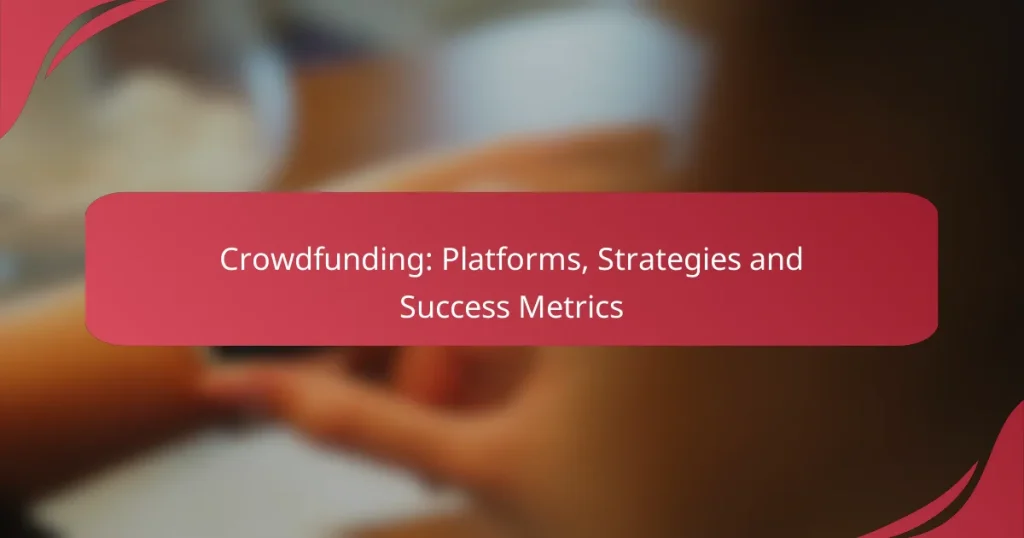Crowdfunding has emerged as a powerful tool for raising funds across various sectors, from creative endeavors to personal causes. Selecting the right platform is crucial, as each offers distinct features and caters to different audiences, impacting your project’s success. By employing effective strategies and understanding success metrics, you can enhance visibility and foster community support, ultimately increasing your chances of achieving your funding goals.

What are the best crowdfunding platforms in the US?
The best crowdfunding platforms in the US cater to different needs, from creative projects to personal fundraising. Each platform has unique features, fees, and target audiences, making it essential to choose one that aligns with your goals.
Kickstarter
Kickstarter is a popular platform for creative projects, including art, music, and technology. It operates on an all-or-nothing funding model, meaning projects only receive funds if they meet their funding goal within a set timeframe.
Creators should prepare a compelling project page with engaging visuals and a clear funding goal. Offering attractive rewards can also incentivize backers. Common pitfalls include setting unrealistic funding goals or failing to communicate effectively with backers during the campaign.
Indiegogo
Indiegogo allows for both fixed and flexible funding options, making it suitable for a wider range of projects. Unlike Kickstarter, projects can keep funds raised even if they don’t meet their goal, which can be beneficial for creators.
Indiegogo supports various categories, including tech, design, and social causes. It’s crucial to market your campaign effectively and engage with your audience throughout the process. Consider using Indiegogo’s InDemand feature to continue raising funds after your initial campaign ends.
GoFundMe
GoFundMe is primarily focused on personal fundraising, such as medical expenses, education costs, or community projects. It operates on a donation-based model, allowing individuals to raise money without offering rewards.
Success on GoFundMe often relies on sharing your story and connecting with potential donors. Creating a heartfelt campaign description and using social media to spread the word can significantly increase visibility. Be aware of the platform’s fees, which can impact the total amount raised.
SeedInvest
SeedInvest is an equity crowdfunding platform that connects startups with investors looking to fund early-stage companies. Unlike donation-based platforms, backers receive equity in the company in exchange for their investment.
To launch a campaign on SeedInvest, startups must meet specific regulatory requirements, including providing detailed financial information. It’s essential to present a solid business plan and demonstrate growth potential to attract investors. Be prepared for a rigorous vetting process before your campaign goes live.
Patreon
Patreon is designed for creators who want to build a sustainable income through subscription-based funding. Fans can support creators by subscribing to different tiers, each offering various benefits or exclusive content.
Creators should focus on delivering consistent, high-quality content to retain subscribers. Setting clear expectations for what patrons will receive at each tier can help build trust and loyalty. Regularly engaging with your audience and offering special perks can enhance the subscriber experience and encourage ongoing support.
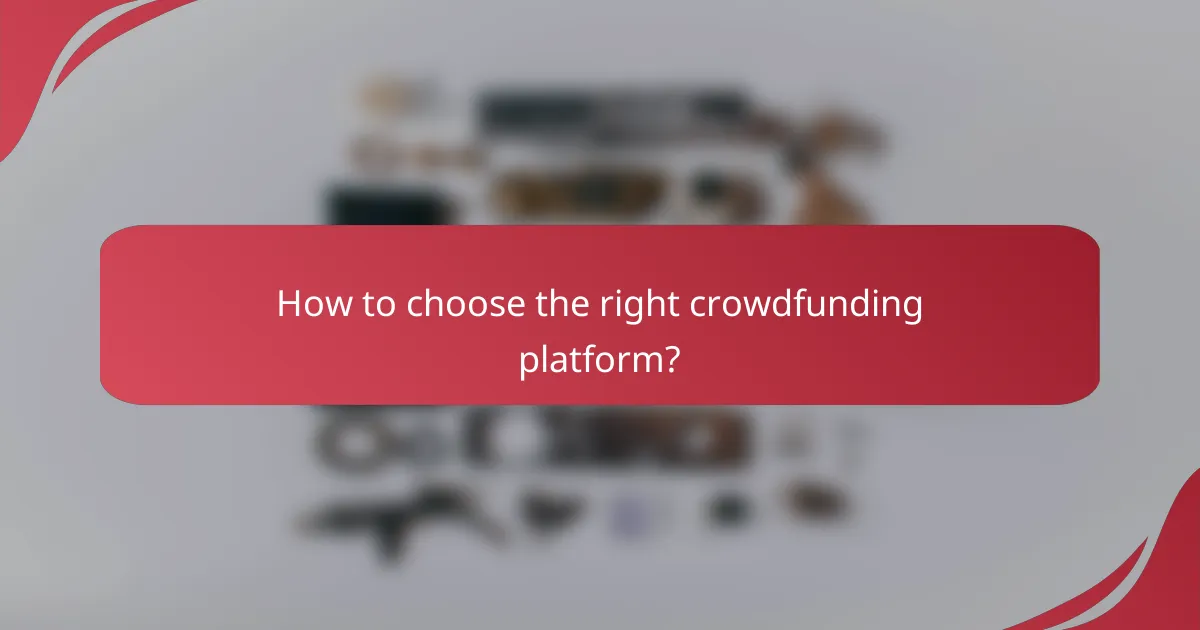
How to choose the right crowdfunding platform?
Choosing the right crowdfunding platform involves evaluating various factors such as fees, audience reach, and specific features that align with your project goals. A well-suited platform can significantly enhance your chances of success and help you connect with the right backers.
Evaluate fees and costs
Different crowdfunding platforms have varying fee structures, typically ranging from 3% to 10% of the funds raised. Additionally, consider transaction fees, which may be charged by payment processors. Calculate the total costs to ensure that the platform fits within your budget.
Some platforms offer all-or-nothing funding, meaning you only receive funds if you meet your goal, while others allow you to keep whatever you raise. Assess which model aligns best with your financial strategy.
Assess audience reach
The audience reach of a crowdfunding platform can greatly impact your project’s visibility and funding potential. Research the demographics and interests of the platform’s user base to ensure they align with your target audience.
Platforms like Kickstarter are known for creative projects, while Indiegogo may cater to a broader range of categories. Choose a platform that has a strong presence in your niche to maximize your chances of attracting backers.
Consider platform features
Each crowdfunding platform offers unique features that can enhance your campaign. Look for tools such as social sharing options, analytics, and marketing support that can help you promote your project effectively.
Some platforms provide customizable campaign pages, while others may include built-in email marketing tools. Evaluate these features to determine which platform can best support your fundraising efforts and help you engage with your backers.
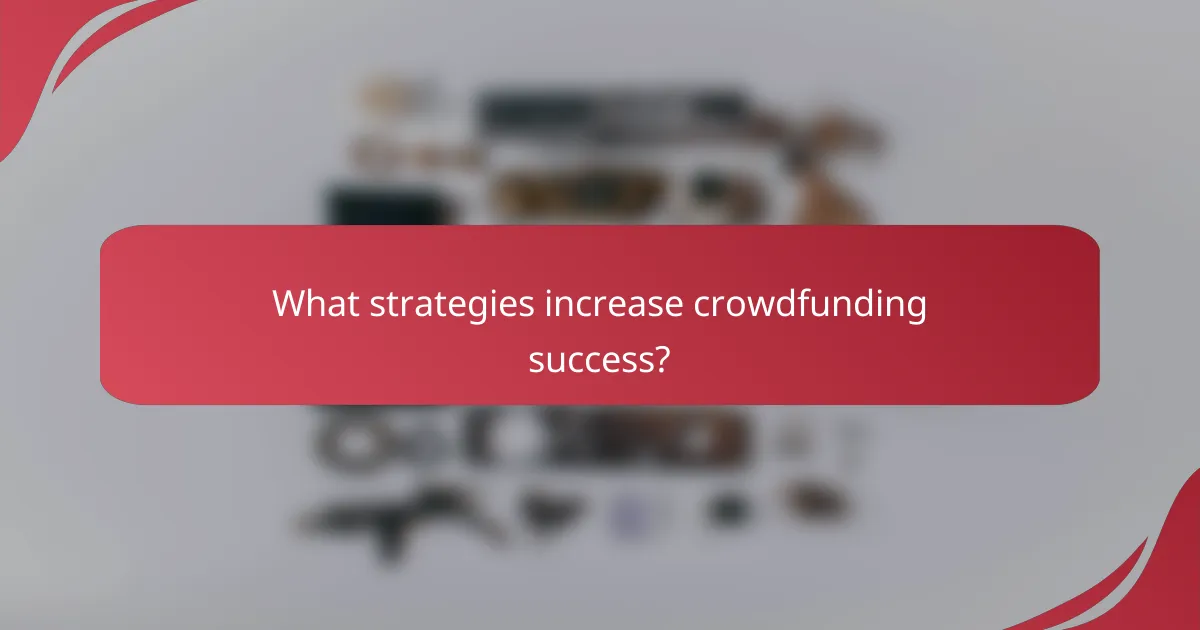
What strategies increase crowdfunding success?
Successful crowdfunding relies on effective strategies that enhance visibility, foster community support, and set achievable goals. Implementing targeted marketing, building a loyal community, establishing realistic funding targets, and crafting compelling narratives can significantly improve the chances of reaching funding objectives.
Effective marketing campaigns
Effective marketing campaigns are crucial for attracting backers to your crowdfunding project. Utilize social media platforms, email newsletters, and online ads to reach a broader audience. Consider allocating 20-30% of your total budget to marketing efforts to maximize visibility.
Engaging visuals and clear calls to action can enhance your campaign’s appeal. Track the performance of different channels to identify which strategies yield the best results, and adjust your approach accordingly.
Building a community
Building a community around your project creates a supportive environment that encourages backers to contribute. Engage with potential supporters through social media, forums, and local events to foster relationships and gather feedback. Consider creating a dedicated online space, such as a Facebook group, where backers can connect and share ideas.
Regular updates and open communication help maintain interest and trust. A strong community can lead to word-of-mouth promotion, which is invaluable for crowdfunding success.
Setting realistic funding goals
Setting realistic funding goals is essential for maintaining momentum throughout your campaign. Analyze similar projects to determine typical funding amounts and timelines. Aim for a target that covers your project’s costs while remaining achievable to encourage backers to contribute.
Consider offering tiered rewards to incentivize larger contributions. A well-structured funding goal can motivate backers to support your project, especially if they see progress toward the target.
Engaging storytelling
Engaging storytelling captivates potential backers and helps them connect emotionally with your project. Clearly articulate your vision, mission, and the problem your project addresses. Use personal anecdotes and visuals to illustrate your journey and the impact of your project.
Highlighting testimonials or endorsements can further enhance credibility. A compelling narrative not only attracts attention but also encourages backers to share your campaign with their networks, expanding your reach.
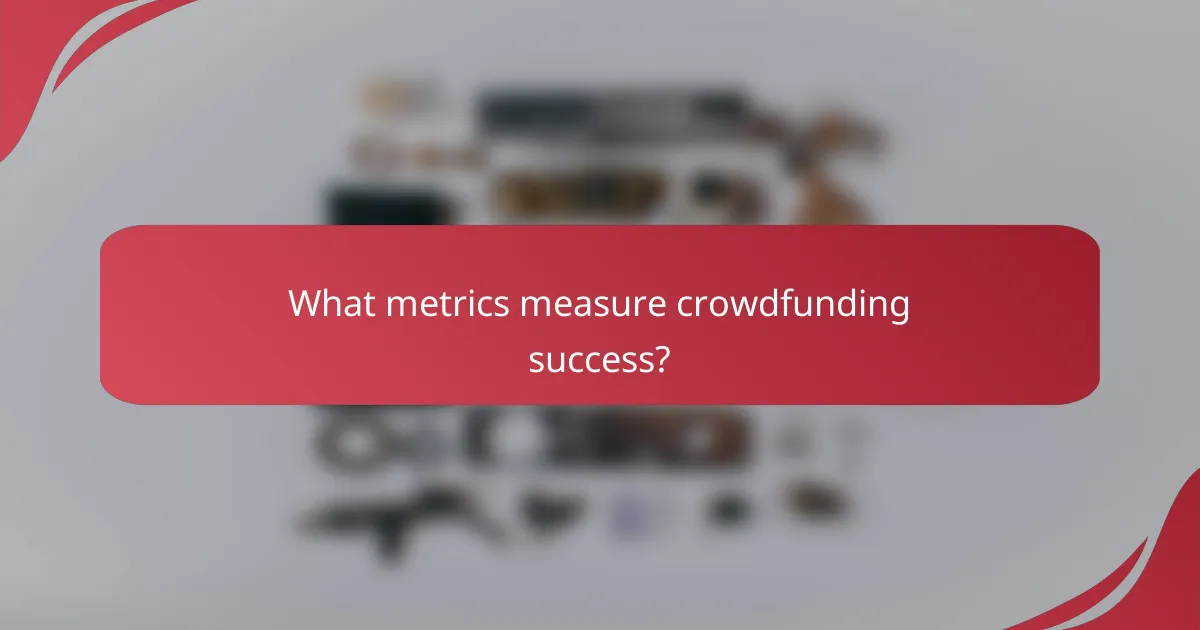
What metrics measure crowdfunding success?
Key metrics for measuring crowdfunding success include funding goal achievement, backer engagement rates, social media shares, and post-campaign sales. These indicators help assess not only the financial outcome but also the overall impact and reach of the campaign.
Funding goal achievement
Funding goal achievement is a primary metric that indicates whether a crowdfunding campaign has met its financial target. A campaign is typically considered successful if it reaches or exceeds its goal, which can vary widely depending on the project type, ranging from a few thousand to several million dollars.
To effectively set a funding goal, consider the total costs of your project, including production, marketing, and platform fees. A well-researched goal that reflects realistic funding needs can significantly enhance the chances of success.
Backer engagement rates
Backer engagement rates measure how actively supporters participate in a campaign, often reflected through comments, updates, and interactions. High engagement rates suggest that backers are invested in the project, which can lead to increased visibility and support.
To boost engagement, regularly update backers on campaign progress and respond promptly to their inquiries. Creating a community around your project can foster loyalty and encourage backers to share your campaign with others.
Social media shares
Social media shares indicate how often your crowdfunding campaign is shared across platforms like Facebook, Twitter, and Instagram. This metric is crucial for expanding your reach and attracting new backers who may not have heard about your project otherwise.
Encourage sharing by creating engaging content, such as videos and infographics, that resonate with your target audience. Consider running social media contests or offering incentives for shares to amplify your campaign’s visibility.
Post-campaign sales
Post-campaign sales refer to the revenue generated after the crowdfunding campaign has concluded. This metric is important for assessing the long-term viability of your project and its potential for continued success in the market.
To maximize post-campaign sales, maintain communication with backers and offer exclusive deals or early access to products. Tracking sales trends can provide insights into customer preferences and help refine future marketing strategies.
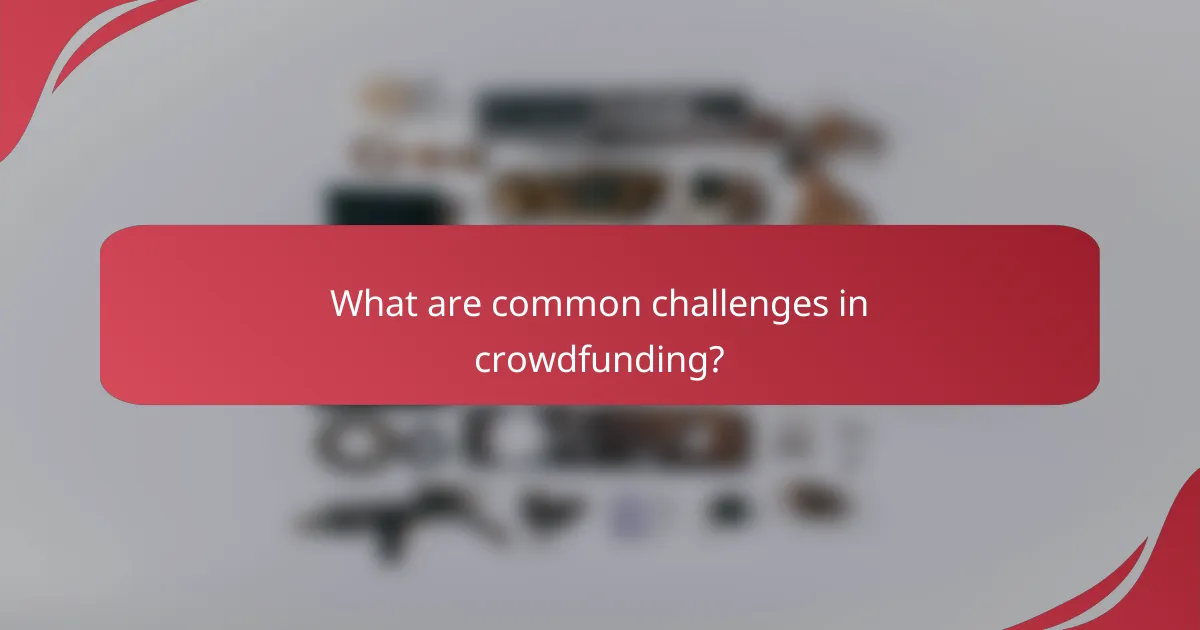
What are common challenges in crowdfunding?
Common challenges in crowdfunding include market saturation, funding shortfalls, and campaign fatigue. These obstacles can hinder a project’s success and require careful consideration and strategic planning to overcome.
Market saturation
Market saturation occurs when too many similar projects flood crowdfunding platforms, making it difficult for individual campaigns to stand out. This can lead to a lack of visibility and engagement from potential backers.
To combat market saturation, project creators should focus on unique selling points and effective marketing strategies. Highlighting what differentiates the project can attract attention in a crowded space.
Funding shortfalls
Funding shortfalls happen when a campaign fails to reach its financial goal, which can result in project cancellation or delays. This often occurs due to unrealistic funding targets or inadequate promotion.
Setting a realistic funding goal based on thorough market research and previous campaign data is crucial. Additionally, engaging with backers through updates and incentives can help maintain momentum throughout the campaign.
Campaign fatigue
Campaign fatigue refers to the diminishing interest from potential backers as they encounter numerous crowdfunding requests over time. This can lead to lower engagement and contributions, especially for projects that run for extended periods.
To mitigate campaign fatigue, creators should keep their campaigns concise and engaging. Regular updates, compelling storytelling, and limited-time offers can help maintain interest and encourage contributions throughout the campaign duration.
